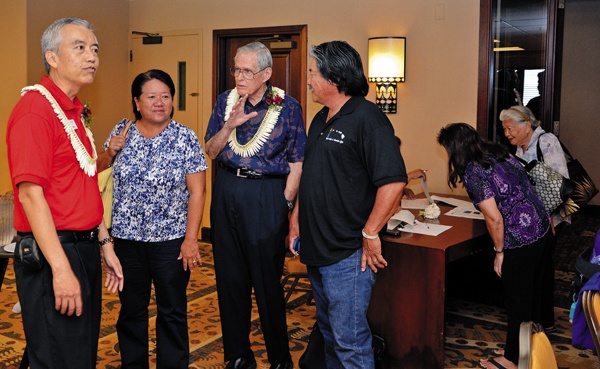WAIPOULI — Esther Snader has worked hard to ensure that she can retire one day, but the 62-year-old Lihue resident said she is concerned about the high insurance premiums that she, like others between 55 to 65 years old, are
WAIPOULI — Esther Snader has worked hard to ensure that she can retire one day, but the 62-year-old Lihue resident said she is concerned about the high insurance premiums that she, like others between 55 to 65 years old, are paying.
“I don’t qualify for Medicare yet, so my premiums are very high as far as health care,” Snader said.
To help address these challenges, officials from AARP Hawaii hosted a forum Saturday at the Courtyard Kauai at Coconut Beach by Marriott, where nearly 150 people listened to social trends and legislative efforts on Medicare and Social Security.
“These are two very complicated subjects that can be difficult to navigate through and understand,” AARP Hawaii Advocacy Director Steven Tam said. “Our goal is to educate people about these two programs.”
AARP Hawaii State President Gerry Silva said Medicare — which consists of four parts designed specifically to cover costs for hospital visits, doctor visits, Medicare Advantage and prescription drugs — has faced a number of pressures over the years.
Health care costs, he explained, are rising faster than the nation’s inflation rate as more people become eligible to receive the federal benefit.
In all, he said the number of people covered by Medicare is projected to more than double from 40 million in 2000 to 81 million in 2030 — a factor that could cause federal spending for the program to reach $1 trillion by 2022.
Silva said the current program is financially solvent but may not be able to pay the full amount of hospital costs within 14 years, if no changes are made to it.
“Is this a Medicare problem? Not so much so as it is basically a health care problem, because those are not Medicare costs — those are health care costs,” Silva said.
But one of the more pressing issues, he pointed out, is there are more Medicare beneficiaries than people paying into it — a factor marked by longer life expectancies and declining birth rates in recent years.
“Have you ever seen one of those jungle movies where you’ve got a python that comes in and eats a pig and you see this big lump going through it? That’s the baby boomers on Medicare,” Silva said to the audience. “It’s not so much the fact that there are more of you. It’s not so much the fact that you are living longer. But, as you get older, there’s always the potential that you’re going to have the kinds of illnesses that are associated with aging.”
Part of the solution, Silva said, is to address an estimated $750 billion in unnecessary health care spending identified by The Institute of Medicine last year, including high service costs, administrative inefficiencies and fraud.
But AARP Hawaii officials say Medicare is not the only federal program that needs to be fixed.
Tam said the trust fund that administers Social Security benefits nationwide is facing a similar dilemma because both programs are affected by the same societal factors.
Social Security, which is primarily funded through payroll taxes, is projected to pay full benefits until 2033, if no changes are made to the program. Under those projections, Tam said the amount of coverage is expected to drop to 75 percent by 2033 and 73 percent by 2086.
“It’s not a situation where there is no money,” Tam said to the audience. “It’s just that there needs to be a way to strengthen Social Security, and not necessarily for you, but for future generations. It’s for the young guys that we want Social Security to still be around.”
The solutions and answers to these issues are mixed.
In a straw poll conducted at the forum, 65 percent of the attendees identified better care coordination as the primary way to reduce Medicare costs, while another 30 percent opted for greater access to generic drugs.
Snader said she supports some of the health care changes identified in the federal Affordable Care Act and is looking forward to January 2014, when The Hawaii Health Connector, the state’s health insurance exchange, is slated to launch.
“I think our age group is very discriminated against because the premiums are very sky high and almost unaffordable for us,” Snader said.
Sheila Vaughan, a 66-year-old Lihue resident, said the federal government and other nonprofit organizations should take a closer look at job creation as a solution.
“It really seems to be taken out of the mix,” Vaughan said.
“When I see this piece discussed, it’s discussed for job creation but it isn’t as it relates to social programs that workers pay into. It’s not funded the same way but it feeds into the funding.”
• Darin Moriki, staff writer and photographer, can be reached at 245-0428 or dmoriki@thegardenisland.com. Follow him on Twitter at @darinmoriki.


